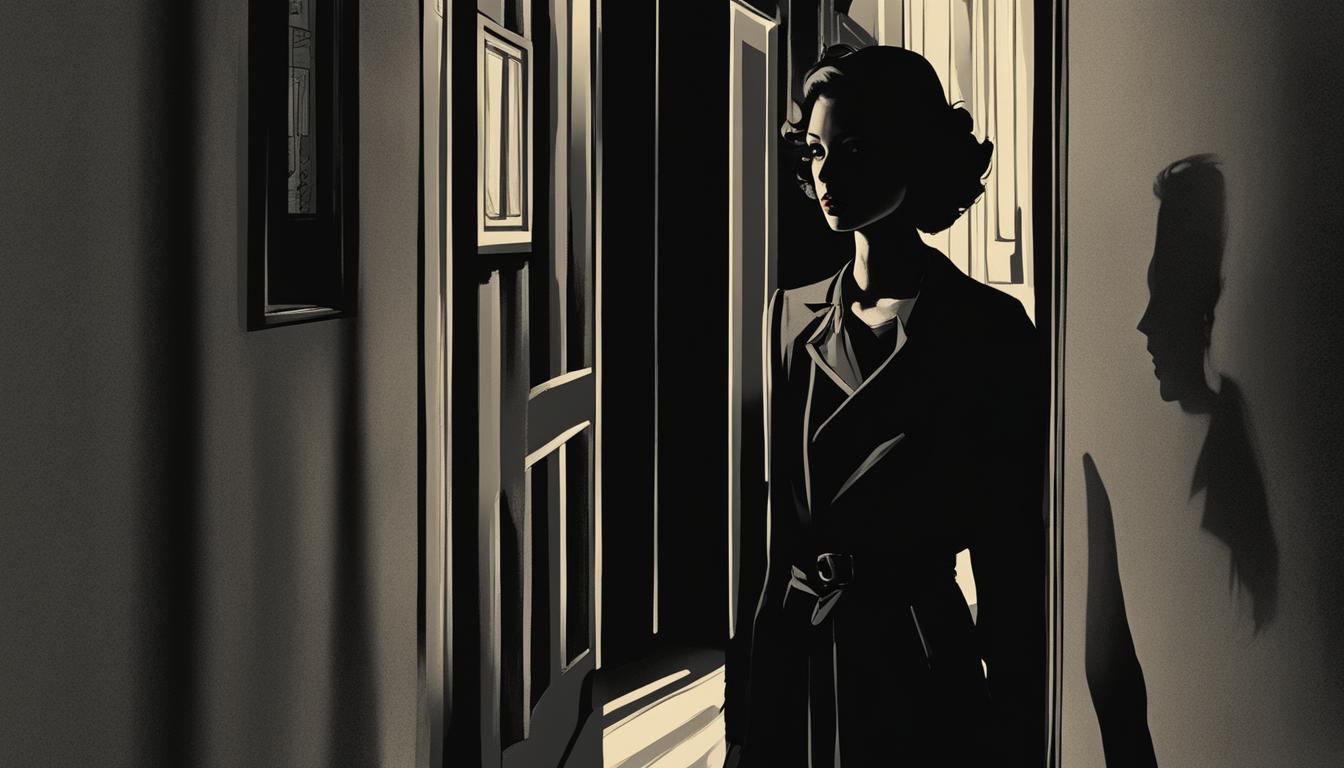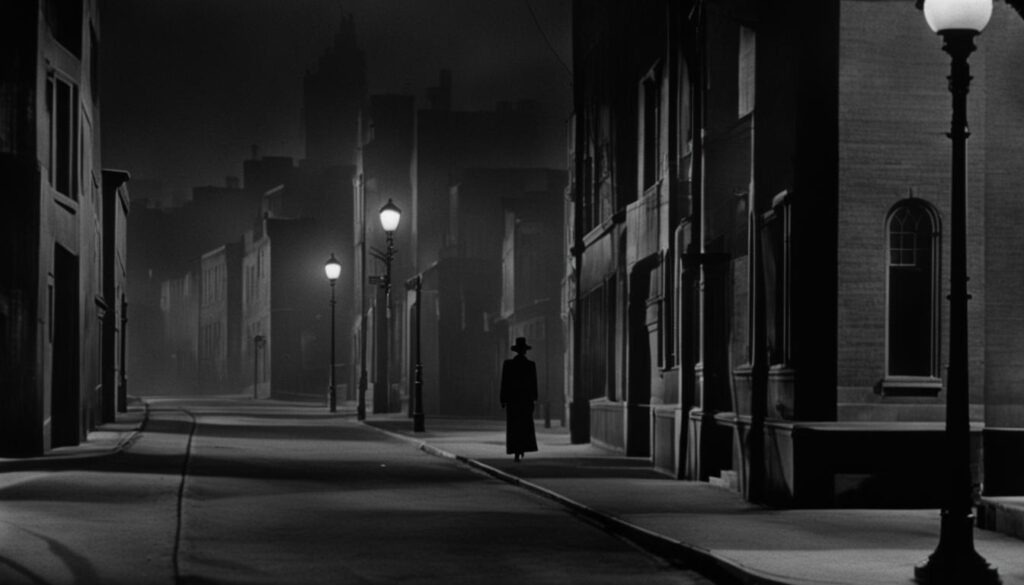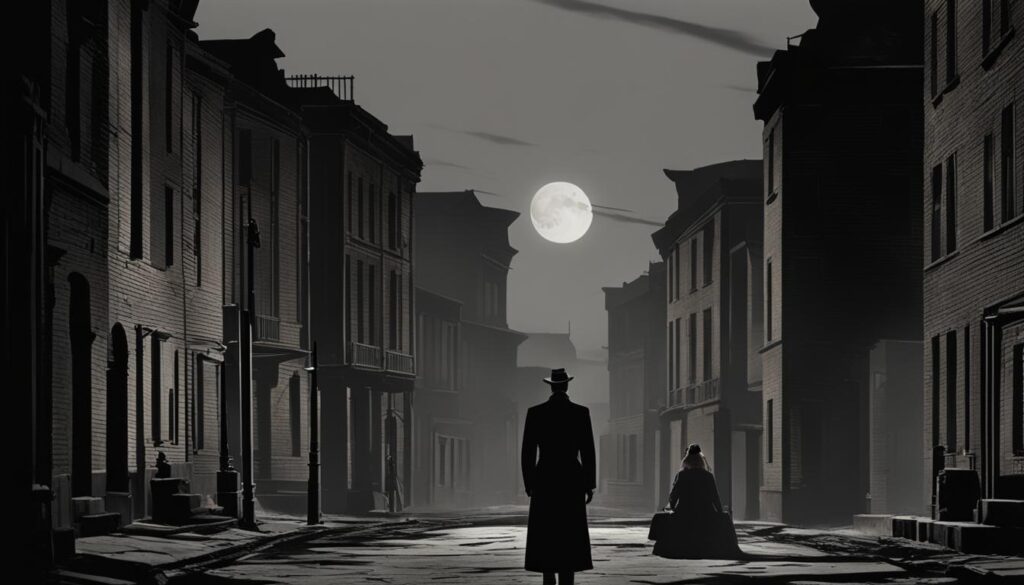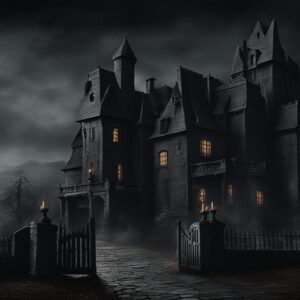When it comes to classic film noir, The Seventh Victim (1943) stands out as a true gem. Directed by Val Lewton, this atmospheric thriller delves into the depths of psychological horror, offering viewers a captivating and thought-provoking cinematic experience.
Val Lewton was known for his unique approach to storytelling, and The Seventh Victim is no exception. With its haunting visuals, complex characters, and exploration of taboo topics, this film remains a standout entry in Lewton’s body of work.
The Seventh Victim takes audiences on a journey into the dark recesses of the human mind, expertly capturing the themes of loneliness, depression, and the struggle for survival. Through its meticulous attention to detail and atmospheric styling, the film engulfs viewers in a world of shadows and secrets.
As we revisit this classic, we are reminded of the enduring legacy it has left on the genre of psychological horror. The Seventh Victim continues to captivate audiences with its timeless themes, reminding us of the power of film to explore the complexities of the human experience.
Key Takeaways
- The Seventh Victim (1943) is a classic film noir directed by Val Lewton.
- The film explores themes of loneliness, depression, and the struggle for survival.
- Val Lewton’s unique approach to storytelling and atmospheric styling make The Seventh Victim a standout entry in his body of work.
- The film’s enduring legacy in the genre of psychological horror is a testament to its captivating storytelling.
- The Seventh Victim reminds us of the power of cinema to delve into the complexities of the human experience.
Val Lewton’s Unique Approach to Mental Health in The Seventh Victim (1943)
Val Lewton’s horror films of the 1940s were known for their distinct and serious exploration of taboo subjects, including mental illness. In his film, The Seventh Victim (1943), Lewton delves into the themes of loneliness, depression, and suicidal ideation with an unflinching approach. By portraying the struggles between light and darkness in the mind, the film emphasizes the choice between life and death. It serves as a content warning for viewers, highlighting the sensitive nature of suicide.
The Seventh Victim presents complex characters like Mary Gibson and Jacqueline, who externalize their internal battles with depression. Through these characters, the film showcases the multifaceted nature of mental health struggles. It invites viewers to reflect on the complexities of depression and the choices individuals face when confronting their darkest thoughts.
In exploring mental health, The Seventh Victim raises important questions about the human condition. It challenges societal norms and the expectations placed upon individuals dealing with depression and suicidal ideation. By showcasing the allure of escape and the affirming power of choosing life, the film invites audiences to question their own perspectives and provides a thought-provoking narrative about the complexities of mental health.
Table: Val Lewton’s Unique Approach to Mental Health in The Seventh Victim (1943)
| Themes | Representation |
|---|---|
| Loneliness | Portrayal of characters seeking connection and solace |
| Depression | Externalization of internal battles through visual symbolism |
| Suicidal ideation | Unflinching approach to the consequences and struggles faced by individuals |
“The Seventh Victim challenges viewers to confront the realities of mental health and the difficult choices individuals must make when faced with extreme emotional distress.” – Val Lewton
By confronting the realities of mental health, The Seventh Victim remains a classic film noir that continues to resonate with audiences. It is a testament to Val Lewton’s unique approach to psychological horror and his ability to address sensitive topics with honesty and depth.
The Influence of German Expressionism in The Seventh Victim (1943)
The Seventh Victim (1943) incorporates elements of German Expressionism, a film movement known for its dark and atmospheric visual style. Similar to German Expressionist films, it features characters who act as thematic doubles or doppelgangers, representing the light and darkness within. Jacqueline and Mary Gibson, the main characters, exemplify this duality. The film’s moody lighting and sharp contrast between shadows and light contribute to its atmospheric tone.
German Expressionism had a significant impact on the development of film noir, a genre that emerged in the 1940s. The Seventh Victim’s incorporation of German Expressionist elements, such as its visual style and the use of thematic doubles, foreshadows the atmospheric qualities that would later become defining characteristics of film noir.
Table: German Expressionism Influence in The Seventh Victim (1943)
| Characteristics | Examples in The Seventh Victim |
|---|---|
| Moody Lighting | The use of shadows and contrast to create an atmospheric tone |
| Thematic Doubles | Jacqueline and Mary Gibson as contrasting characters representing light and darkness |
| Visual Symbolism | Scenes like the “Night Walk” sequence that evoke a sense of dread and psychological tension |
The incorporation of German Expressionism in The Seventh Victim not only adds to its atmospheric thriller qualities but also reflects the film’s exploration of the complex themes of mental health, depression, and survival. The unique stylistic qualities influenced by German Expressionism contribute to the enduring legacy of The Seventh Victim as a classic film worth revisiting.
The Seventh Victim’s Exploration of Loneliness and Depression
The Seventh Victim delves deep into the themes of loneliness and depression, offering a raw and unflinching portrayal of mental health struggles. Through compelling characters and a thought-provoking narrative, the film sheds light on the debilitating effects of these emotions and the desperate search for connection.
The character of Jacqueline serves as a powerful representation of the impact of loneliness on mental well-being. Her journey explores the consequences of seeking solace in unconventional ways, such as involvement with a cultic group called the Palladists. The film invites viewers to reflect on the negative consequences of isolation and the desperation to find meaning and connection, even in unconventional and potentially harmful ways.
The exploration of depression and its effects is a significant aspect of The Seventh Victim’s narrative. By examining the complexities of mental health, the film provides a poignant and thought-provoking look into the human condition. It challenges viewers to confront their own perspectives on loneliness, depression, and the choices individuals make when confronted with emotional distress.
Throughout the film, Loneliness and Depression are depicted as powerful adversaries that the characters must contend with. The Seventh Victim’s exploration of these themes adds depth and nuance to its atmospheric thriller elements, creating a compelling viewing experience that lingers long after the credits roll.
| Loneliness | Depression |
|---|---|
| The film showcases the debilitating effects of loneliness on mental well-being. | The characters’ struggles with depression are portrayed with raw honesty and depth. |
| Loneliness drives the characters to seek connection, even in unconventional and potentially harmful ways. | Depression is externalized through symbolism, such as the hangman’s noose, offering a visceral representation of the characters’ internal battles. |
| The exploration of loneliness highlights the negative impact of isolation and the desperate search for meaning and connection. | The film challenges societal norms by addressing depression head-on and inviting viewers to reflect on the complexities of mental health. |
| Loneliness serves as a driving force in the narrative, amplifying the characters’ struggles and adding depth to the film’s themes. | The Seventh Victim’s exploration of depression provokes thoughtful analysis and encourages dialogue about the realities of mental health. |
The Palladists and the Sinister Secret Society in The Seventh Victim (1943)
The Seventh Victim introduces the Palladists, a secret society described as a society of Devil worshippers. However, the film presents them as sophisticated, serious, and pacifistic, aiming to debunk sensationalist notions. The Palladists become intertwined with Jacqueline’s story, as they believe she has revealed their existence to a psychiatrist. The group’s methods of dealing with outsiders involve psychological manipulation rather than violence, aiming to convince their intended victims to commit suicide. The Palladists’ presence adds an element of mystery and danger to the narrative, while also exploring the themes of religion and spirituality.
Throughout the film, the Palladists remain shrouded in secrecy, conducting their activities behind closed doors. Their rituals and practices are hinted at but not fully revealed, leaving much to the viewers’ imagination. This ambiguity contributes to the enigmatic atmosphere of the film and adds to the sense of intrigue surrounding the Palladists as a secret society.
The Palladists’ role in The Seventh Victim showcases Val Lewton’s commitment to exploring complex and unconventional themes in his horror films. By presenting the Palladists as morally ambiguous characters rather than traditional villains, Lewton challenges the audience’s expectations and encourages them to question their own biases and assumptions. The Palladists’ manipulation tactics and their involvement in Jacqueline’s story serve as a chilling reminder of the dangers of fanaticism and the power of psychological coercion.
The Internal Struggle with Depression in The Seventh Victim (1943)
The Seventh Victim (1943) explores the internal battle with depression and the profound struggle faced by individuals dealing with suicidal ideation. The film’s narrative and visual storytelling techniques skillfully externalize these internal battles, providing viewers with a poignant portrayal of the complexities of mental health.
One of the powerful visual representations used in the film is the hangman’s noose suspended above an empty chair. This haunting image symbolizes the weight of depression and the loneliness experienced by the characters. It serves as a stark reminder of the internal struggles they face and the constant presence of their darkest thoughts.
The Seventh Victim also highlights the internal struggle through the narrative itself. The Palladists, a sinister secret society within the film, attempt to convince Jacqueline, one of the main characters, to commit suicide. This externalization of her internal battle underscores the profound choices individuals face when confronted with their darkest thoughts and emotions.
The Impact of Externalization
The film’s unique approach to externalizing internal battles invites viewers to reflect on the complexities of mental health. By making the struggles tangible and visible, The Seventh Victim sheds light on the intensity of the internal struggle faced by individuals dealing with depression and suicidal ideation.
Through its visual symbolism and narrative storytelling, The Seventh Victim encourages a deeper understanding and empathy for those living with mental health challenges. It challenges viewers to confront the realities of depression and the choices individuals must make when faced with their darkest moments. The depiction of the internal struggle with depression in The Seventh Victim provokes thoughtful analysis and fosters a greater awareness of mental health issues.
The Stylistic Qualities of The Seventh Victim (1943) as Film Noir
The Seventh Victim (1943) showcases distinct stylistic qualities that position it firmly within the genre of film noir. The film’s masterful use of lighting, shadows, and contrasting tones contributes to its atmospheric and moody tone, creating an immersive experience for viewers. The interplay between light and darkness mirrors the internal struggles faced by the characters, emphasizing the morally ambiguous nature of the narrative.
This atmospheric thriller also employs archetypal characters commonly found in film noir, such as the naive poet and the cynical doctor. These characters add depth and complexity to the story, providing a stark contrast between the idealistic and disillusioned perspectives that define the genre. Their interactions and conflicts propel the narrative forward, keeping audiences captivated throughout.
The Seventh Victim (1943) stands as a testament to the enduring legacy of film noir, expertly incorporating the genre’s stylistic qualities into a gripping and thought-provoking narrative. The film’s use of lighting, character archetypes, and moral ambiguity creates a visually captivating and emotionally resonant experience.
The film’s enduring influence can be seen in its influence on subsequent works within the film noir genre and its lasting impact on the broader cinematic landscape. Its stylistic qualities and atmospheric tone continue to inspire filmmakers and engage audiences today, solidifying its status as a classic example of film noir.
| Stylistic Qualities | Description |
|---|---|
| Use of Lighting | The film utilizes dramatic lighting techniques, with stark contrasts between light and shadow, to emphasize the psychological tension and moral ambiguity of the narrative. |
| Character Archetypes | The Seventh Victim employs archetypal characters commonly found in film noir, such as the naive poet and the cynical doctor, to explore the complexity of human nature and the moral gray areas they inhabit. |
| Moral Ambiguity | The film presents morally ambiguous situations and choices, highlighting the blurred lines between good and evil in a dark and unforgiving world. |
The Seventh Victim (1943) remains a standout example of film noir, showcasing the genre’s stylistic qualities and narrative depth. Its profound influence on subsequent works and its continued relevance in contemporary cinema solidify its place as a classic film worth revisiting for its atmospheric thriller elements and thought-provoking themes.
The Night Walk Sequence in The Seventh Victim (1943)
The Seventh Victim features a haunting and iconic night walk sequence that showcases the film’s atmospheric thriller elements and pays homage to the influence of German Expressionism. In this sequence, Jacqueline, the film’s protagonist, is relentlessly pursued through the shadowy streets of Greenwich Village by a mysterious figure wielding a menacing knife. The tension builds as the camera follows every step, capturing Jacqueline’s fear and desperation.
The night walk sequence is a visual masterpiece, with dynamic cinematography and effective use of light and shadow. The dimly lit streets, flickering street lamps, and elongated shadows create a sense of unease and suspense, immersing the audience in the dangerous atmosphere. This sequence exemplifies the film’s atmospheric thriller genre and its connection to German Expressionism, known for its use of distorted and exaggerated visuals to convey the characters’ internal struggles and emotions.
The night walk sequence serves as a metaphorical representation of Jacqueline’s internal battles with depression and suicidal ideation. As she flees her pursuer, the scene becomes a physical manifestation of her fight for survival and her attempts to escape the depths of her despair. The sequence highlights the film’s exploration of mental health and the lengths individuals go to confront their darkest thoughts and find a reason to continue living.
The Choice Between Life and Death in The Seventh Victim (1943)
In Val Lewton’s atmospheric thriller, The Seventh Victim (1943), the exploration of depression and suicidal ideation presents audiences with a profound choice between life and death. The film raises thought-provoking questions about the value of existence and the complexities of mental health. It challenges viewers to examine their own perspectives on survival and confront the realities faced by individuals dealing with extreme emotional distress.
In The Seventh Victim, the character Jacqueline is confronted with the allure of escape from her depression through the influence of the Palladists, a secret society. While the Palladists attempt to convince her to take her own life, Jacqueline is given the option to refuse throughout the film. This pivotal choice serves as a narrative centerpiece, inviting viewers to reflect on the power of choosing to live and the strength it takes to confront one’s darkest thoughts.
The film provides a gripping portrayal of the internal struggle faced by individuals dealing with depression and suicidal ideation. Through its narrative and visual symbolism, The Seventh Victim externalizes the characters’ battles, highlighting the complexities of mental health. By presenting the choice between life and death, the film sparks introspection and encourages dialogue about this important topic.
| Choice | Life | Death |
|---|---|---|
| Meaning | Embracing the challenges and finding purpose | Succumbing to despair and giving up |
| Impact | Inspiring others and making a difference | Leaving loved ones with unanswered questions |
| Survival | Fighting against the odds and finding strength | Submitting to the darkness and losing hope |
The Unflinching Approach to Suicide in The Seventh Victim (1943)
The Seventh Victim tackles the sensitive subject of suicide with an unflinching attitude, shedding light on the consequences and struggles faced by individuals dealing with depression and suicidal ideation. The film’s portrayal of mental health serves as a content warning for viewers, acknowledging the potentially sensitive nature of the topic. Through its narrative, The Seventh Victim challenges societal taboos and invites audiences to confront the harsh realities of mental health.
By exploring the internal battles of its characters, the film delves into the complexities of depression and the difficult choices individuals face when confronted with extreme emotional distress. Symbolic sequences, such as the hanging noose and the locked room with poisoned wine, externalize the internal struggles experienced by the characters, providing a profound insight into their mental states.
The raw and unflinching approach to suicide in The Seventh Victim provokes thought and dialogue about mental health, encouraging viewers to reflect on the complexities of the human experience. It sheds light on the challenges faced by those dealing with depression and serves as a reminder of the importance of empathy and understanding in our society.
| Key Points | Impact |
|---|---|
| The film’s unflinching portrayal of suicide | Raises awareness about the struggles faced by individuals dealing with depression and suicidal ideation |
| The depiction of internal battles through symbolism | Offers a profound insight into the complexities of mental health |
| Exploration of the harsh realities of depression | Challenges societal taboos and encourages thought and dialogue |
The Seventh Victim stands as a testament to the film’s unflinching and thought-provoking exploration of suicide and mental health. Its impact goes beyond the realm of entertainment, challenging viewers to confront their own perspectives and fostering empathy for those facing the darkest moments of their lives.
The Externalization of Internal Battles in The Seventh Victim (1943)
In Val Lewton’s psychological horror film, The Seventh Victim (1943), the internal battles faced by the characters are powerfully externalized through the film’s narrative and visual symbolism. One of the most striking examples of this is the recurring image of a hangman’s noose suspended above an empty chair. This haunting visual represents the depression and suicidal ideation that the characters, particularly Jacqueline, grapple with throughout the film. It serves as a harrowing reminder of the constant struggle between life and death, bringing the characters’ internal battles into vivid focus.
Another powerful symbol of internal battles in The Seventh Victim is the locked room containing poisoned wine. This room serves as a metaphorical representation of Jacqueline’s desperate desire to escape her emotional pain through self-destruction. The locked door symbolizes the barriers she faces in finding a way out, while the poisoned wine suggests the allure of an easy escape. These externalized representations of internal battles emphasize the complexity of mental health and the profound effects it can have on individuals.
The Seventh Victim expertly employs visual symbolism and narrative devices to externalize the internal struggles faced by the characters. These externalizations provide viewers with a deeper understanding of the complexity of mental health and the profound impact it can have on individuals’ lives. By externalizing these battles, the film invites audiences to reflect on the complexities of mental health and the choices individuals face when confronted with their darkest thoughts.
The Seventh Victim’s Externalization of Depression
In The Seventh Victim, depression is expertly externalized through the film’s use of visual symbolism and narrative techniques. One example is the recurring image of the hangman’s noose, which serves as a chilling representation of the characters’ internal battles with suicidal ideation. Additionally, the locked room with poisoned wine symbolizes the constant struggle to find a way out of emotional pain. These externalizations effectively convey the depths of despair experienced by the characters, fostering a greater understanding of the complex nature of mental health.
The Choice to Live in The Seventh Victim (1943)
In the atmospheric thriller, The Seventh Victim (1943), the themes of survival and depression are explored through the characters’ choices to live. The film challenges societal expectations by highlighting the importance of embracing life, even in the face of extreme emotional distress. Through the character of Jacqueline, viewers witness the allure of escape and the constant struggle to find meaning in existence.
Amidst themes of loneliness and despair, The Seventh Victim presents a thought-provoking narrative that prompts audiences to question their own perspectives on the value of life. The film showcases the complexities of mental health and the difficult choices individuals face when confronted with their darkest thoughts. It depicts the internal battles experienced by the characters, externalizing their struggles through powerful visual symbolism.
Through its unflinching portrayal of depression and suicidal ideation, The Seventh Victim invites viewers to reflect on the profound challenges faced by those dealing with mental health struggles. By emphasizing the choice to continue living, the film underscores the importance of seeking connection and finding meaning in a world that often seems bleak. The Seventh Victim’s exploration of these themes adds depth and nuance to its atmospheric thriller elements, making it a classic worth revisiting.
The Role of Loneliness in The Seventh Victim (1943)
The Seventh Victim (1943) delves into the theme of loneliness as a significant factor in the characters’ struggles with mental health and depression. The film portrays the debilitating effects of social isolation on individuals’ well-being, highlighting the desperate search for connection that can arise from intense feelings of loneliness. Jacqueline, the main character, seeks solace in the Palladists, a cultic group, as a means of escaping her profound solitude. This exploration of loneliness offers viewers a poignant portrayal of the human condition, emphasizing the importance of genuine human connection in maintaining emotional well-being.
Loneliness is a silent torment, slowly gnawing at the soul. In The Seventh Victim, we witness the devastating impact of isolation on the characters’ mental health. Through Jacqueline’s desire to find belonging, the film exposes the depths of her loneliness. The allure of escape offered by the Palladists underscores the desperation she feels, ultimately leading her down a treacherous path. The Seventh Victim serves as a reminder of the profound impact loneliness can have on individuals and the importance of fostering meaningful connections to combat its destructive force.
This emphasis on loneliness is a significant aspect of The Seventh Victim, contributing to its exploration of depression and mental health. By examining the consequences of isolation, the film offers a raw and unflinching portrayal of the struggles individuals face when grappling with profound feelings of loneliness. The Seventh Victim prompts viewers to reflect on their own experiences with loneliness and the impact it can have on mental well-being, encouraging them to cultivate supportive relationships and foster connections to prevent the debilitating effects of isolation.
The Role of Loneliness in The Seventh Victim (1943)
Loneliness in The Seventh Victim is a powerful driving force behind the characters’ actions and emotional states. The film explores the depths of this loneliness, showcasing its potential to push individuals to seek escape through unconventional means. The Seventh Victim serves as a haunting reminder of the human need for connection and the devastating consequences that can arise when that need goes unfulfilled. Through its exploration of the role of loneliness, the film provokes thought about the complexities of mental health and the importance of fostering genuine connections to combat the destructive power of isolation.
The Influence of Val Lewton’s Production Style in The Seventh Victim (1943)
Val Lewton’s production style in The Seventh Victim (1943) is a key factor in creating the film’s atmospheric thriller elements. Known for his ability to evoke mood and tension through visual storytelling, Lewton’s approach elevates the film to a standout example of psychological horror. Through effective use of lighting, shadow play, and other techniques, he creates a sense of unease and suspense that permeates the narrative.
One of the defining traits of Lewton’s production style is his skillful play with light and shadows. In The Seventh Victim, this technique is employed to create an eerie and foreboding atmosphere throughout the film. The contrast between dark and light adds depth to the scenes, amplifying the psychological tension and contributing to the overall sense of unease.
The Seventh Victim’s Production Style: Key Elements
In addition to his mastery of lighting and shadows, Lewton’s production style in The Seventh Victim incorporates other key elements that further enhance the atmospheric thriller experience. His meticulous attention to detail and ability to create rich, complex characters adds depth and nuance to the narrative. The film’s exploration of taboo topics, such as mental health and suicide, is handled with sensitivity and insight, showcasing Lewton’s commitment to psychological depth.
| Key Elements of Val Lewton’s Production Style in The Seventh Victim (1943) |
|---|
| Masterful use of lighting and shadows to create mood and tension |
| Meticulous attention to detail in set design and visual composition |
| Complex and psychologically rich characters |
| Sensitive and nuanced exploration of taboo topics |
Overall, Val Lewton’s production style in The Seventh Victim (1943) sets it apart as an atmospheric thriller that continues to captivate audiences. His ability to evoke emotion, create rich visuals, and explore complex themes contributes to the enduring legacy of the film. It remains a testament to Lewton’s skill as a filmmaker and a compelling example of psychological horror.
The Legacy of The Seventh Victim (1943)
The Seventh Victim (1943) is a classic film that has left an indelible mark on the genre of atmospheric thrillers. Directed by Val Lewton, this lesser-known gem explores the themes of mental health, loneliness, and depression with a depth and honesty rarely seen during its time. Its lasting legacy lies in its ability to captivate audiences with its complex characters, atmospheric visuals, and thought-provoking narrative.
Val Lewton’s unique production style shines through in The Seventh Victim, creating an immersive and unsettling viewing experience. The film’s use of lighting, shadow play, and storytelling techniques set the stage for an atmospheric thriller that keeps audiences on the edge of their seats. Lewton’s attention to detail and dedication to psychological depth make The Seventh Victim a standout entry in his body of work, cementing his reputation as a master of the genre.
The Complex Characters and Timeless Themes
The Seventh Victim is elevated by its complex characters, each grappling with their own demons in a world filled with shadows. Jacqueline, the film’s protagonist, becomes entangled in a web of despair as she confronts the allure of escape from her inner turmoil. As viewers follow her journey, they are forced to question their own perspectives on life, death, and the complexities of mental health. The film’s timeless themes continue to resonate with audiences, inviting introspection and thoughtful analysis.
A Standout Entry in Psychological Horror
The Seventh Victim represents a pivotal moment in the history of psychological horror. It defies conventions and delivers a bold narrative that challenges societal norms and expectations. Its unflinching approach to topics like loneliness, depression, and suicide provokes thought and discussion, leaving a lasting impact on viewers. This classic film remains a testament to Val Lewton’s innovation and artistry, carving a permanent place for itself in the annals of cinema.
Conclusion
After diving deep into the world of Val Lewton’s The Seventh Victim (1943), it’s clear that this classic film noir is a must-watch for fans of atmospheric thrillers. With its unflinching exploration of mental illness, the film offers a thought-provoking narrative that tackles taboo topics like depression, loneliness, and suicidal ideation.
Through the use of German Expressionism and its incorporation of film noir elements, The Seventh Victim creates a visually striking and moody atmosphere that adds depth and complexity to the storytelling. The presence of the Palladists, a mysterious secret society, adds an element of danger and intrigue to the narrative, further exploring the themes of religion and spirituality.
This film’s legacy continues to resonate with audiences, captivating them with its atmospheric visuals, complex characters, and timeless themes. The Seventh Victim challenges viewers to confront their own perspectives on life, death, and the complexities of mental health, leaving them with a profound sense of introspection long after the credits roll.
FAQ
What is The Seventh Victim (1943) about?
The Seventh Victim explores themes of loneliness, depression, and suicidal ideation through the story of a woman named Jacqueline who becomes involved with a cultic group called the Palladists.
How does The Seventh Victim approach the subject of mental health?
The film takes a serious and unflinching approach to mental illness, portraying the struggles faced by individuals dealing with depression and suicidal thoughts.
Does The Seventh Victim contain any content warnings?
Yes, the film includes a content warning for its depiction of suicide, acknowledging the potentially sensitive subject matter.
What is the influence of German Expressionism on The Seventh Victim?
The film incorporates elements of German Expressionism, a film movement known for its atmospheric and moody visual style, adding to its suspenseful and dark tone.
What is the Night Walk sequence in The Seventh Victim?
The Night Walk sequence is a recurring element in Val Lewton’s horror films, including The Seventh Victim. It showcases Jacqueline being pursued through the shadowy streets by a menacing figure, creating a sense of dread and suspense.
How does The Seventh Victim explore the choice between life and death?
The film presents characters, particularly Jacqueline, with the choice between living and succumbing to depression and suicide. It challenges societal expectations and explores the complexities of mental health.
What is Val Lewton’s production style in The Seventh Victim?
Val Lewton’s distinctive production style is characterized by atmospheric visuals, psychological depth, and an emphasis on creating mood and tension through lighting and shadow play.
What is the legacy of The Seventh Victim?
The Seventh Victim is considered a classic film that continues to captivate audiences with its atmospheric thriller elements and thought-provoking exploration of mental health and survival.
What is the conclusion of The Seventh Victim?
The film leaves the ultimate decision between life and death up to individual interpretation, challenging viewers to reflect on their perspectives on the value of existence and the complexities of mental health.







